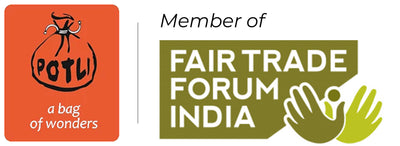Our Artisans

Our Story: Crafting Culture Through Creativity
Our founder, Pooja Ratnakar is a visionary in the crafts sector, dedicated to preserving and promoting India's rich cultural heritage through innovative educational initiatives. As the co-founder of Potli, she has spearheaded a vision to engage children in meaningful explorations of tradition, creativity and craftsmanship.
Pooja’s journey into the world of cultural education and crafts began from her childhood, with travels and most of the family holidays in the rural parts of India which led to a deep-rooted passion for cultural heritage and a desire to instil awareness, love and appreciation in younger generations. Recognizing the need for accessible and engaging resources, she co-founded Potli, a brand committed to empowering children with knowledge and creativity as well as helping artisans to keep their arts and crafts alive, and preserving centuries-old traditions for future generations to enjoy.
At Potli, these nostalgic memories are the heartbeats of our inspiration. We are a visionary brand passionate about Indian culture, art forms, and natural wonders, and we invite you to immerse yourself in this vibrant tapestry with us.
Our Vision
A future where every child has the opportunity to explore, celebrate, and cherish India’s diverse cultural heritage with pride and joy. With Potli as a catalyst for learning and discovery, we hope that children develop a deeper appreciation for diversity, empathy, and creativity. Our vision is one of empowerment, enlightenment, and endless possibilities for the generations to come.
We believe that by empowering children to celebrate India's art, music, dance, and traditions, we contribute to a more inclusive and culturally aware society. Our dream is to inspire the leaders of tomorrow to cherish, preserve, and promote India's cultural legacy as they embark on their own unique journeys.

Our Mission
To foster a deep appreciation for India's rich cultural heritage among children and nurture among them, a sense of pride and curiosity about our diverse cultural traditions and knowledge.
Through thoughtfully curated DIY kits, Potli provides children with hands-on experiences that not only foster creativity and critical thinking but also deepen their understanding of their cultural roots. Our commitment to innovation ensures that Potli's offerings remain relevant, engaging, and impactful in today's rapidly evolving world.
Beyond Creativity - Empowering Artisans
At Potli, we value community and collaboration deeply. We work hand-in-hand with local artisans, and other stakeholders, actively supporting their craft and ensuring their skills are celebrated and passed down to younger generations. By empowering these talented individuals, we not only improve their livelihoods but also play a vital role in safeguarding India's rich and diverse artistic heritage. We are committed to pay royalty to the Folk artists we work with, for every kit that sells, and till it sells.

Pooja Ratnakar, Founder
If you ask Pooja what she does, she likes to describe herself as an avid traveller, painter and writer - Pooja, an alumna of NIFT, is the creative force behind Potli. With a deep love for India's artistic heritage, she envisioned a brand that celebrates traditional craftsmanship and empowers local artisans. Her dedication to preserving and sharing the wonders of Indian art and culture has made her an avid advocate for awareness and preservation. Pooja's passion led to the creation of Potli, where she develops DIY kits for kids based on Indian folk art forms. Her cultural roots run deep, and she has worked towards creating livelihoods for rural artisan communities, particularly in Orissa and West Bengal. Pooja's fusion of artistic vision, cultural appreciation, and social responsibility continues to guide Potli on its remarkable journey, making it a beacon of creativity and a catalyst for positive change in the community.
Schools we have worked with














